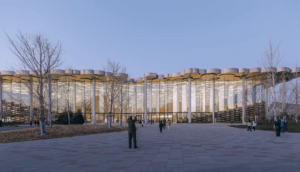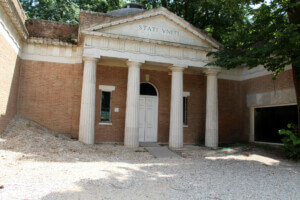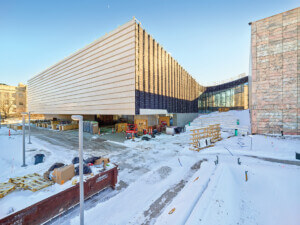In 2010, director Wim Wenders created a 3D video installation at the Venice Architecture Biennale about the Bolex Learning Center in Lausanne, Switzerland, called If These Walls Could Talk. The ability to visually explore the building and simulate being inside the space that the medium affords inspired him to team up with Robert Redford to create a 3D series called Cathedrals of Culture, which will be shown at the IFC Center in New York beginning on May 1.
And talk they do. There are six half-hour films, all by different directors, shown in two programs, and five of them are narrated by the buildings themselves. Each is given a voice, which describes the feelings and observations of the structures. So we hear in the first person from the Berlin Philharmonic (Hans Scharoun), the Oslo Opera House (Snohetta), Halden Prison (EMA), The National Library of Russia (Yegor Sokolov), and the Centre Pompidou (Renzo Piano and Richard Rogers). Only the Salk Institute (Louis Kahn) doesn’t employ this technique and is the most successful program.
At Salk, it’s the perfect melding of brief and building, science and art, the two sparking each other off to make magic. It is now complemented by a like-minded film. Directed by Robert Redford and with stunning cinematography by Ed Lachmann and music by Moby, the film captures the essence of the building and molds the spaces.
Kahn’s structure clearly affects the work of the scientists, who speak about “genius loci,” the spirit of place. There’s a wonderful image of the staff assembled in a circle and then fanning out across the plaza, like a living organism. We see and hear both Jonas Salk and Louis Kahn, and learn that they raised each other’s game and made a better building; Salk insisted Kahn throw out the first design, and Kahn rebuts that the client isn’t an architect. Then Salk says “eventually Lou Kahn became quite a biologist, and I came to appreciate the importance of aesthetics…to bring out the spirit and soul of man.” The campus is filled with light, which hits home when Edward R. Murrow asks Salk who owns the patent for the polio vaccine?: “The people,” he replies. “Would you patent the sun?”
In the same program is the Centre Pompidou by Karim Ainouz, a Brazilian filmmaker who studied architecture. He spends most of the episode inside the building, maximizing 3D by floating through tunnels, galleries, elevators, back-of-house spaces and the main hall which is treated like an airport arrival and departure lounge. The shot of a window washer gliding up the clear glass-walled escalator holding a sponge in one hand followed by a squeegee in another and letting the upward glide of the moving staircase do the work is pure ballet. The voice of the building is Deyan Sudjic, Director of the Design Museum in London and former editor of Blueprint magazine, who intones “In a digital century, a world of flickering pixels… a machine for culture that I am, which once seemed so violent, so threatening, has the nostalgic charm now of a steam engine.”
IFC Center. http://www.ifccenter.com
Part 1:
The Berlin Philharmonic. Director, Wim Wenders
The National Library of Russia. Director, Michael Glawogger
Halden Prison. Director, Michael Madsen
Part 2:
The Salk Institute. Director, Robert Redford
The Oslo Opera House. Director, Margreth Olin
Centre Pompidou. Director, Karim Ainouz










